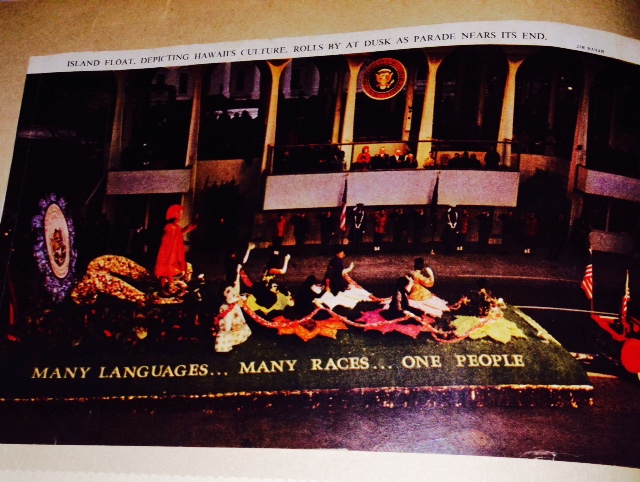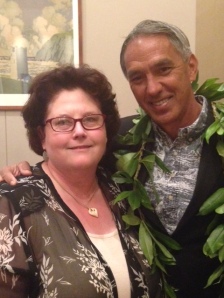Hokule‘a is in the water now, sailing up the coast from the Capitol in Washington, D.C. to New York City. She is a Hawaiian wa‘a kaulua (ocean canoe), the guiding light of a nation, the Hawaiian nation, called the people of the wa‘a.
She is a small vessel with a small crew that includes a pwo navigator, one who has been schooled in the ancient art of Polynesian Wayfinding. Relying solely on knowledge handed down from generation to generation about the movement of the stars, the rising and setting of the sun, water and air currents and the habits of sea life and water fowl, the navigator guides his crew to their destination. While there are many on-going conversations and opinions about contemporary Hawaiian nationhood, there is unified support for the importance of the Hawaiian principles that sail with Hokule‘a during this historic voyage called Malama Honua – taking care of Island Earth. Simply put,
I nā mālama ‘oe i ka ‘āina, na ka ‘āina mālama iā ‘oe
If you take care of the land, the land will take care of you.
 This past week, while the crew was in D.C., the annual lei-draping ceremony to adorn the statue of King Kamehameha in the Capitol building was moved up a bit to allow this event to coincide with the arrival of Hokule‘a on the East Coast leg of a journey that started two years and 26,000 miles ago in Hawaii. ‘Oiwi TV has been filming the voyage and a link to the whole ceremony can be found here. The image that most moved me was the one with the king and the navigator. King Kamehameha and Pwo Navigator Nainoa Thompson are two different kinds of warriors. Kamehameha I is credited with uniting the Hawaiian Islands under one rule. For the most part, it was violent and bloody with a little diplomacy thrown in – the total antithesis to the contemporary tourist’s perspective of Hawaii. However, it can be argued that the unification of the Hawaiian Islands prevented the type of European colonization that occurred throughout the Pacific during the 19th century. The Kingdom of Hawaii became a recognized, sovereign nation by leaders around the world.
This past week, while the crew was in D.C., the annual lei-draping ceremony to adorn the statue of King Kamehameha in the Capitol building was moved up a bit to allow this event to coincide with the arrival of Hokule‘a on the East Coast leg of a journey that started two years and 26,000 miles ago in Hawaii. ‘Oiwi TV has been filming the voyage and a link to the whole ceremony can be found here. The image that most moved me was the one with the king and the navigator. King Kamehameha and Pwo Navigator Nainoa Thompson are two different kinds of warriors. Kamehameha I is credited with uniting the Hawaiian Islands under one rule. For the most part, it was violent and bloody with a little diplomacy thrown in – the total antithesis to the contemporary tourist’s perspective of Hawaii. However, it can be argued that the unification of the Hawaiian Islands prevented the type of European colonization that occurred throughout the Pacific during the 19th century. The Kingdom of Hawaii became a recognized, sovereign nation by leaders around the world.
The statue of the first Hawaiian monarch is the only statue of a king in the U.S. Capitol. I remember when it was first installed, along with the statue of Father Damien (now Saint). It was a tremendous event for the D.C. Hawaiian community. For me, as a youth trying to hold on to my “Hawaiian-ness” it was a real validation of my heritage as an American and an Hawaiian. Years later I would study about the illegal overthrow of the Hawaiian monarchy and start to revise my own opinion about the relationship between Hawaii and the U.S. government, but for this recognition of Hawaii and Hawaiians, I still get a thrill seeing this statue in the Capitol.
 The theme of unity was one that resonated with my mother, Kanoelani O’Connor, when Governor Burns asked her and her colleague Col. Raymond Fernandez to design the float for the State of Hawaii entry in the 1968 Inaugural Parade. Our cousin, Clyde Dupont, was pressed into service to impersonate Kamehameha, complete with feathered malo, mahiole (helmet) and ʻahu ʻula (cape). Women from the Hawaii State Society represented the diverse ethnic groups that still make up the fabric of life in Hawaii. Each woman was placed on one of the islands in culturally appropriate costume and all of the islands were joined together by one lei. The motto: “Many Languages…Many Races…One People” was a theme that would inspire my mother on other projects and the words remain one of her greatest lessons to me about the power of aloha to unite diverse peoples towards a common goal. Since Hawaii was the 50th State, the float was the last to pass the review stand and as the setting sun illuminated the golden attire of my cousin, who was freezing to death in his malo that cold January day, the eloquence of form and word was not lost on a country feeling greatly divided. This spectacular float, designed by and featuring people of Hawaii was the only float to make Time magazine’s feature article on the Inauguration. I can only
The theme of unity was one that resonated with my mother, Kanoelani O’Connor, when Governor Burns asked her and her colleague Col. Raymond Fernandez to design the float for the State of Hawaii entry in the 1968 Inaugural Parade. Our cousin, Clyde Dupont, was pressed into service to impersonate Kamehameha, complete with feathered malo, mahiole (helmet) and ʻahu ʻula (cape). Women from the Hawaii State Society represented the diverse ethnic groups that still make up the fabric of life in Hawaii. Each woman was placed on one of the islands in culturally appropriate costume and all of the islands were joined together by one lei. The motto: “Many Languages…Many Races…One People” was a theme that would inspire my mother on other projects and the words remain one of her greatest lessons to me about the power of aloha to unite diverse peoples towards a common goal. Since Hawaii was the 50th State, the float was the last to pass the review stand and as the setting sun illuminated the golden attire of my cousin, who was freezing to death in his malo that cold January day, the eloquence of form and word was not lost on a country feeling greatly divided. This spectacular float, designed by and featuring people of Hawaii was the only float to make Time magazine’s feature article on the Inauguration. I can only

imagine how Hawaiians felt that day as the image of King Kamehameha I along with the Seal of the State of Hawaii bearing those sacred words Ua mau ke ea o ka ‘aina i ka pono, passed by the President of the United States and thousands of spectators gathered along Pennsylvania Avenue. My mother thought that Hawaii could teach the world how diverse peoples could live and thrive together. She was a hula dancer and it was an intrinsic part of her personality to offer hospitality, refuge, food, mele, hula, compassion – whatever was required of her guests.
In Kamehameha’s day, uniting the people of Hawaii into one nation was what was required. For my mother in her day, sharing lei aloha was the way to inspire unity in a country at war internally and externally. Today, Hokule‘a sails throughout the world’s oceans weaving a different sort of lei, a lei comprised of the stories of hope gathered from communities all over the world to inspire the international community to appreciate our Island Earth and accept our human responsibility to malama the world and each other. Pwo Navigator Nainoa Thompson and the other navigators and crew of Hokule‘a are warriors in their own right. They are skilled watermen and waterwomen, scientists, educators, artists, musicians, dreamers, and family men and women who have volunteered their service and their lives to crew this little vessel on a mission to witness and search for ways we can all malama Island Earth. And they do this with the spirit of aloha – the central theme of Hawaiian life.

As a member of the board of Halawai, Inc., it has been my privilege to work with a dedicated community of Hawaiians and friends of Hawaii in New York City to prepare for the arrival of Hokule‘a. As a person who has a fear of the water it’s somewhat ironic that I am so in awe of this wa’a. But I am drawn to the aloha and hope that sails with her connecting the knowledge of our Kupuna (ancestors) to that which is required for the world and its people to thrive in the 21st century.
He waʻa he moku, he moku he waʻa.
The canoe is our island, and the island is our canoe.
Note: Ua mau ke ea o ka ‘aina i ka pono (The Life of the Land is Perpetuated in Righteousness) – attributed to King Kamehameha III.


Thanks for sharing, Deb!
LikeLike